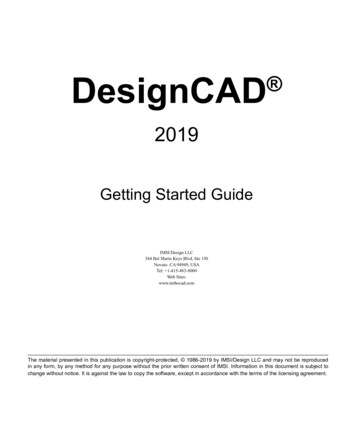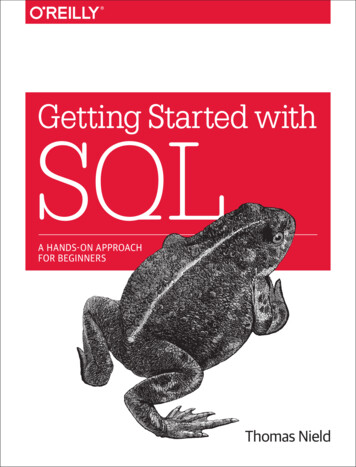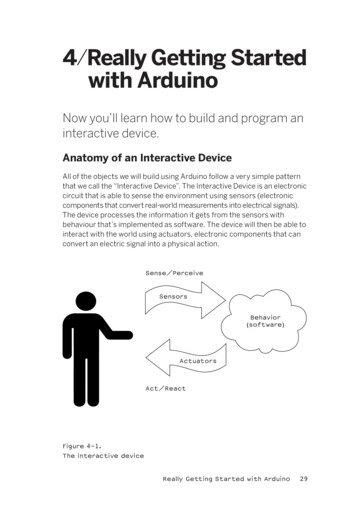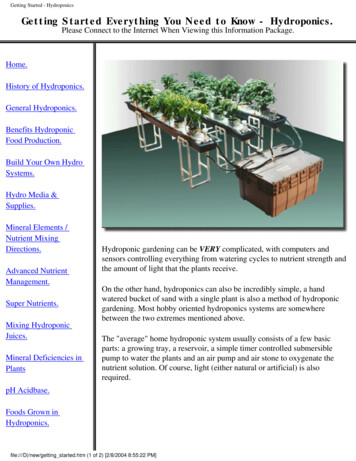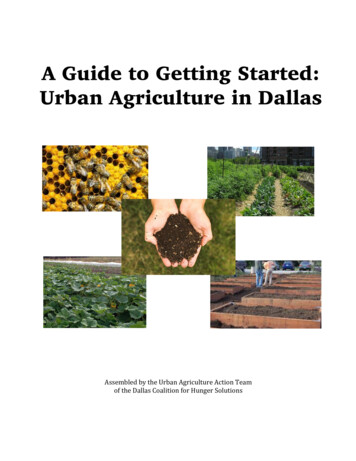
Transcription
!!!!!!!!!!!!!!!!!!!!!!!!!!!!!!!!!!!!!!!!!A Guide to Getting Started:Urban Agriculture in !!
A Guide to Getting Started:Urban Agriculture in DallasTable of ContentsIntroduction1. Identifying PropertyA. OwnershipB. Negotiating use of the land – finding an owner, rental/lease contracts, liabilityC. ZoningD. Existing StructuresE. Additional allowed usesa. Residential land (what’s allowed from a home)b. Commercial land (gardens as accessory use at churches & businesses)2. Cultivating the Land – what’s allowed with Urban Garden COA. Building regulationsB. FencingC. Animals and BeesD. SalesE. ParkingF. AquaponicsG. CompostH. Other information and resourcesa. Soil testingb. Additional potential licenses and regulations (florist for cut flowers, eggs)c. Insuranced. Community garden resources3. Obtaining the Certificate of Occupancy – steps with the cityA. What’s needed for a COB. Water metersAppendix A – Glossary of TermsAppendix B – Aquaponics Permits for Texas!2!
IntroductionA Guide to Getting Started: Urban Agriculture in Dallas is brought to you by the UrbanAgriculture Action Team, a collaboration supported by the Dallas Coalition for HungerSolutions. Our mission is to empower residents to gain equal access to healthy food.Urban agriculture is increasingly recognized by city authorities and communities for the manybenefits it brings such as the following: Strengthening the resilience of the urban food system, Promoting access to healthier food, Promoting economic opportunity, income and entrepreneurialism Helping neighborhoods revitalize themselvesThis guide will provide you with information on the new Dallas code amendments as well asdescribe best practices for growing food in an urban environment and will walk you through aseries of topics to be considered as you are putting together an urban agriculture project.!Laterversions will provide tips for marketing and selling produce at neighborhood and farmersmarkets.Our goal is to make it easier for our community members to grow and sell food in theirneighborhoods as a way to promote economic development and improve access to fresh,nutritious food. Whether the project is a community garden or an income-producing farmingoperation, this guide is intended to help leaders understand the current city ordinances for urbanfood production as well as think through the items that must be considered when embarking onan urban agriculture project.This guide reflects the city ordinances at the time it was written. Every effort will be made toensure that it is kept up to date, but please know that changes can happen in between editions.!3!
Urban Agriculture Flow ChartIdentify VacantPlot of LandIs the OwnerIdentified?noResearch OwneryesObtain Permissionto UseDetermine CurrentZoningDetermineStructure, Set BacksFencing andLicensing Based onZoningyesLicense Examples:Animals, Eggs,Hydroponics, CutFlowers, AquaponicsIs soilcontamiated?CleanContaminants/Amend SoilnoIs there a watersource on theproperty?noApply For a WaterMeteryesHave Meter SetTo Have WaterTurned OnInstall FencingBeginGardening!4!
Part 1: Identifying PropertyA. OwnershipOwnership of the property for a community garden or urban agriculture project must beestablished in order to obtain permission to use the property for this purpose.If ownership is known and the landowner is a participant in the urban agriculture project, thenthe project can proceed. If ownership is not known, the owner must be found and contacted toobtain formal permission for use of the land.Land ownership information can be obtained from the Dallas County Appraisal District(www.dcad.org) by searching for the property address. The owner can then be contacted via theaddress listed on the Appraisal District record. If an owner is not easily contacted, another pieceof property might need to be considered.B. Negotiating Use of LandIn almost every possible situation, it is recommended that a written agreement be in placebetween the landowner and the group or individual creating the urban agriculture project, even ifthese two parties are a church and a group within the church. Having a written agreement,however simple, will prevent problems from occurring later. This is not because trouble isexpected but so that a clear understanding is established for all involved.Written agreements can be as simple as a Memorandum of Understanding (MOU) that states thatthe landowner is allowing the group or individual to use the specific piece of land for the specificpurpose. Any additional limitations, expectations, or possibilities can be listed in the MOU. Thenrepresentatives from each party sign the document. These written agreements can be as formal asa lease drawn up by an attorney. While a formal lease is not required by the City of Dallas, itmay be the best document to have in place if the landowner is not a participant in the urbanagriculture project. A rental agreement is another option, especially when money is paid to thelandowner at an agreed upon schedule.If an agreement is difficult to negotiate, consider a different piece of landLiability is another reason to have an agreement in place. The agreement should outline who willhold insurance on the property and for which purpose .In 2015, the Texas Legislature passed HB 262 that limits the liability for landowners who allowtheir land to be used for community gardens. “HB 262 protects landowners from liability if theyallow their land to be used for community gardens, absent willful, wanton or grossly negligentconduct by the landowner,” Farm and Ranch Freedom slative-report). For additional specific information onthis bill, go tory.aspx?LegSess 84R&Bill HB262.!5!
Obtaining legal advice maybe beneficial in the following situations: Land negotiation becomes complicated The project becomes more complex Costs for the land seem to becoming more expensive The feeling that someone may be taking advantage of your or the garden project in theshort term or the long term.If you feel the need to consult a lawyer, the following resources maybe able to help:SMU – Law School clinic - http://www.law.smu.edu/clinics/get-help-now or call 214-768-2562Dallas Bar Association - http://dallasvolunteerattorneyprogram.orgC. ZoningZoning is the way land use is defined and regulated. The City of Dallas has many differentzoning types within the city code. The two main divisions are Residential zoning andCommercial zoning. Within each, there are multiple subdivisions. Each subdivision will haveslightly different rules about setbacks, fencing, and other details.Zoning is the most important item that will affect how you farm your selected property. Forinstance, all zoning types can be used for urban agriculture, but depending on the exact zoning,rules for buildings and fences and parking will vary.For the purpose of an urban agriculture project, the main difference between Residential andCommercial zoning is that in Commercial zoning designations sales of fruits and vegetablesraised are allowed while in Residential zoning, on-site sales is not allowed.D. Existing Structures on Land & Accessory UseIf there is an existing structure on a piece of property, different rules apply, and the UrbanGarden ordinance may not apply. If there is NO existing structure on the property, see Section 2for information.An existing structure is a building - such as a house, church, school, library, warehouse, etc –that is in use.Accessory use:Accessory use is the term used when the garden or urban food project is on land adjacent to anexisting structure, whether commercial or residential. Gardens are allowed as accessory use.Again, recommendations are that a simple written agreement be created between the landowner(s) and the group or individual creating the urban agriculture project.Land with an existing house:!6!
If the piece of land used for urban food production has a home that is inhabited, the UrbanGarden ordinance does not apply At an occupied home, food production and sales (off-site) areallowed by right. If the house on the land is unoccupied and will not be occupied for residentialuse with the start of the urban agriculture project, then .Land with existing multi-family housing:If the piece of land used for urban food production has a multi-family building or severalbuildings, such as an apartment complex, that is inhabited, the Urban Garden ordinance does notapply because the food production is considered accessory use.Land with an existing commercial building:Commercial buildings are buildings that have been or are being used for commercial businesses.These include, but are not limited to buildings such as stores, warehouses, and gas stations.Churches are also included in the commercial building category. Urban food production isallowed at these sites and considered accessory use.Part 2: Cultivating the Land or what’s allowed with Urban Garden COA. Building regulations – In planning an urban garden, you will want to consider at least astorage shed for tools and other equipment and supplies. For urban gardens in a residentialzoning, no more than 10% of a vacant lot can be covered with a structure. No single structurecan be more than 200sq ft in size.For example, if a lot is 7500 sq ft, the garden is allowed to 750 sq ft of buildings on the lot.So, a garden with this lot size might have three 200 sq ft buildings and one 150 sq ft building.The total amount of the buildings can total 10% of the total lots size as long as no building ismore than 200 sq ft.Raised beds or structures supporting bed cover are not considered buildings.B. Fencing – Fencing rules vary based on the land zoning. Each type of zoning has specificrequirements for fences. Typically, there is a standard set back for fences that line streets or afence in what would be considered the front yard.Urban garden projects will want to consider whether fencing is needed and the appropriatetype of fencing for the project and the zoning designation.C. Animals and Bees – Chickens, bees, and aquaponics are allowed on an urban garden. Allother animals, whether for grazing or production, are prohibited except in certain zoningareas with a Special Use Permit. Other rules may apply with respect to signage, licenses, andsales for gardens with chickens, bees, or aquaponics.!7!
D. Sales – Sale of food produced in an urban garden is allowed. If the garden is on acommercially zoned property, sales can occur on-site. Other requirements such as parkingand facilities may apply. Check zoning rules for these. If the garden is on a residentiallyzoned property, sales on-site are not allowed. Sale at a neighborhood or farmers market is anoption for any urban garden.E. Parking – Parking is not required for urban gardens unless there is on-site sales (nonresidential only). Then one off-street parking space is required for every 200 square feet ofsales area with a minimum of two off-street parking spaces.F. Aquaponics – Aquaponics (see glossary for definition) is allowed in an urban garden. Inorder to properly operate an aquaponics system, especially if any sales from the system willoccur. See Appendix for this information.G. Compost – Composting is allowed in urban gardens; however, proper practices will ensurethat the compost pile(s) do not become a draw for unwanted rodents and other animals. Theeasiest way to avoid this problem is to never add meat, other animal products, or dairy to thecompost system. Many resources for proper composting are available for free.H. Other information and resourcesa. Soil testing – Soil tests generally report the nutrient levels contained in soil. Manydifferent types of tests area available. One of the easiest ways to do a soil test isthrough Texas AgriLife Extension.If a garden is suspected to be in an area with contaminated soil, a soil test is verynecessary to test for heavy metals. Tests for these are available commercially. Be surethe test is appropriate for use with soil.b. Additional potential licenses and regulations (florist for cut flowers, eggs)Cut flowers – For commercial sale (any sale at a public location) of flowers, aflorist permit may need to be obtained. These rules can be found at the TexasDepartment of Agriculture website.Eggs – A person may sell eggs produced by chickens they own at a neighborhoodor farmers market. The eggs must be kept at 45 F. If the eggs are sold by anotherperson or sold to a business for use or sale (such as a restaurant or grocery store),then other rules apply and additional permits may be needed.c. Insurance - It is strongly recommended that urban gardens should have some type ofliability coverage for any accidents that might occur. In addition, product liability isneeded if produce is to be sold to the public.d. Community garden resources – Many resources for community gardening areavailable on the Internet. One of the best places to start is the American CommunityGardening Association website (https://communitygarden.org). As this guidedevelops, other resources will be added.!8!
Part 3: Obtaining the Certificate of Occupancy (CO)A. What’s needed for a Certificate of Occupancy – The Certificate of Occupancy (CO) letsthe City know how you are using your particular piece of property and help you know whatis allowed with in that use.Remember: the CO will be needed if you are starting a garden on a vacant piece of land or ifyou are changing the use of the property such as with a commercially zoned property.Gardens that are on the property of a church or other business or community facility will notneed their own CO.To obtain a CO, visit the City’s municipal offices at 320 E. Jefferson Blvd. in Oak Cliff,room 118. Their hours are 8:00 to 4:30, Monday through Friday.First, visit the Zoning office. Give the address of the lot you intend to farm, and the person inzoning will go over the zoning regulations for the area in which the lot is located, and goover any restrictions with you. Certain areas may have additional restrictions or existingoverlays, such as in PD 380 in the Bishop/Davis area or PD 595 in South Dallas/Fair Park.For the CO, a map of the site will be needed. Currently, an official plat map of the lot will berequired. Copies of a plat are not expensive. Some lack of clarity exists in whether urbangardens will be required to re-plat the land. Since this can cost a few hundred dollars, acompromise solution will be sought to make it affordable for urban gardens to meet the needsof the city. The CO takes 2-4 weeks to process and to be issued. The cost is 280.**Regardless of the plat map issue, an urban garden will be required to provide a site map,drawn to scale, that shows the layout for the planned garden. These site maps should identifywhere growing beds, walkways, any shade structures, storage sheds or other buildings, andcompost piles will be located on the lot. This is something that a garden must decide onbefore moving any further through the process.B. Water Meters – The office to visit about a water meter is in the same building at 320 E.Jefferson Blvd as the Zoning office. They will pull a map of the neighborhood, which showswhere the water mains are located.To find out if a water line needs to be run to the property, and cost of a water meter, call 214670-8213 (Water Department Operations).A water meter must be installed by a utilities contractor hired by the garden leaders. Costsare estimated to range from 1800 to 2500. More information regarding water meterinstallation will be added to this section in future versions.**!NOTE: Wait until just before planting and operations to order a water meter – to haveone put in much ahead of time may mean the meter is tampered with or you will be payingfor someone who comes and helps him/herself to your water!!9!
Appendix A – ��!(aka ivestock!in!or!predators!out.!Fertilizer!J "hoop"!shape.!10!
enclosed!structure.!Landscaping!J eatures!of!an!area!of!land. ed!of!organic!compounds.Organic!Certification - l; ��a!method!of!growing!plants!on!walls.!11!
lic!water!supply!system.Appendix B – Aquaponics Permits for TexasCurrent as of August 2015If an aquaponics operation plans to sell its fish, there are three species that may be aquaculturedwith an Exotic Species Permit from Texas Parks and Wildlife: Blue, Nile, and Mozambiquetilapia.The ONLY tilapia species you can have on your property for personal use (i.e. not for sale to thepublic) without an Exotic Species Permit is MOZAMBIQUE tilapia. In order to be in possessionof Mozambique tilapia without a permit you must maintain a copy of your exotic speciestransport invoice with a valid permit number from the group you purchased the fish from.There is no permit required (other than a fishing license) to catch and put into your aquaponicssystem blue gill, bass, crappy or catfish.3 Step Process for an Exotic Species Permit:1. Obtain a TCEQ permit exemption form recognizing that the operation doesn’t have anywastewater runoff. This can be downloaded from the TCEQ website. It does not seem to be acomplicated form. Contact Melinda Luxemburg with TCEQ at 512-239-4541 or emailat Melinda.Luxemburg@tceq.texas.gov for more information on how to obtain this permit.2.Once the form is complete, send it to Rick Garza at Texas Department of Agriculture to obtainan aquaculture license 512-936-2430 or email at rick.garza@TexasAgriculture.gov. There willbe some paperwork to complete with Rick as well.3. Finally, send in a copy of the TCEQ exemption and Aquaculture permit along with yourcompleted Exotic Species application to Luci Cook-Hildreth at Texas Parks and Wildlife Dept.The form is downloadable from forms/ . Clickon Exotic Species Permit or Renewal (PWD-1026) (Word51 KB) (for commercial andagricultural operations).The application fee is 263. Once TPWD has received all this information a TPWD biologistwill get in touch with you to make arrangements to inspect your facility. Once your facility haspassed inspection your permit will be issued. All permits expire on December 31st in the year!12!
they are issued. There is a 27 fee to renew the Exotic Species permit each year. For help, atTPWD, contact Luci Cook-Hildreth at 512-389-8750.!13!
Urban Ag Success ProjectCommunity GardeningResourcesGENERALAmerican Community Gardening Associationhttps://communitygarden.org/Start A Community Food Garden: The Essential HandbookJoy LaManda, Timber Press, December 2014, 224 pagesSTART-UP & HOW-TO GUIDESUniversity of CaliforniaCommunity garden start-up dfClemson UniversityStarting a community s/vegetables/gardening/extension community gardening.pdfNorth Carolina State UniversityHow to organize a community a-community-gardenUniversity of MissouriA community garden scpubs/mp0906.pdfWorld Hunger Relief, Inc. & Heart of Texas Urban Gardening CoalitionCentral Texas community gardening al-1.pdfLEGALChangeLab SolutionsGround rules: a legal toolkit for community ault/files/CommunityGardenToolkit Final (CLS 20120530) 20110207.pdfGOVERNMENTLet’s MoveCommunity garden checklistUSDA NRCSCommunity garden guide: vegetable garden planning and developmenthttp://www.nrcs.usda.gov/Internet/FSE AL ASSISTANCESustainable Food Center, AustinCommunity garden leader trainings and ing for this project is provided by the USDA Office of Advocacy and Outreach.
Urban Ag Success ProjectUrban FarmingResourcesURBAN FARMING BOOKSThe Essential Urban FarmerNovella Carpenter & Willow Rosenthal, Penguin Books, December 2011, 592 pagesSustainable Market Farming: Intensive Vegetable Production on a Few AcresPam Dawling, New Society Publishers, February 2013, 456 pagesThe Market GardenerJean-Martin Fortier, New Society Publishers, March 2014, 240 pagesThe Organic Farmers Business HandbookRichard Wiswall, Chelsea Green Publishing, October 2009, 224 pagesORGANIZATIONALNCAT/ATTRAStart a farm in the mary.php?pub 21Cornell Small Farms ProgramGuide to Urban Farming in New York uides/Grow NYCVarious factsheets and cationsResource Centres on Urban Agriculture & Food SecurityVarious hangeLab SolutionsDig, eat & be healthy: a guide to growing food on public ions/dig-eat-be-healthyChangeLab SolutionsDigging In: local policies to support urban -agChangeLab SolutionsSeeding the city: land use policies to promote urban cations/seeding-cityLEGALThe Urban Agriculture Legal Resource Libraryhttp://www.urbanaglaw.org/!! SPIN FARMINGhttp://www.spinfarming.com/buy/**Funding for this project is provided by the USDA Office of Advocacy and Outreach.
A Guide to Getting Started: Urban Agriculture in Dallas is brought to you by the Urban Agriculture Action Team, a collaboration supported by the Dallas Coalition for Hunger Solutions. Our mission is to empower residents to gain equal access to healthy food. Urban agriculture is increasingly r


